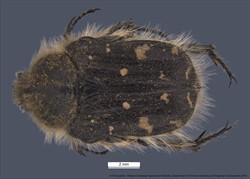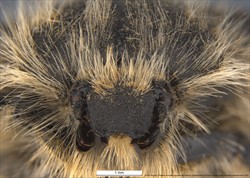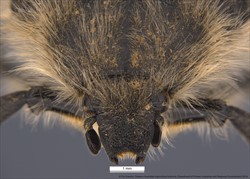Sub family: Cetoniinae / Tribe: Cetoniini / Genus: Tropinota / Subgenus: Epicometis
Fact Sheet
Tropinota (Epicometis) hirta (Poda, 1761)
Small to medium beetles with a broadly rounded psterior, body length: 8-13mm, body colour grey to black. Densely covered in long cream/white setae. Clypeus with apex deeply emarginate, punctuated and setose. Pronotum without scale spots, and with a medially raised, longitudonal carina. Patches of microtrichia present on the elytra, similar to Glycyphana. Elytra with shallow striae and irregularly shaped, rounded punctations. raised third interstriae keel occasionally present anteriorly, and an elytral suture keel present. Mesometasternal process present, not projecting beyond mesocoxa, punctated and setose, with a truncated/broadly rounded and shiny margin. Foretibia tridentate.
Commonly called the Apple Blossom Beetle, the adult beetles of Tropinota hirta are recognised pests on a large number of cultivated plants. They can cause significant damage by feeding on flowers and early stage fruit such as apple, pear, plum, cherry trees, and many ripening berry plants. They are also known to damage cereals inlcuding rye, canola, wheat, barley and lupins, and can feed on weedy flowers of dandelions and broomerape. There are reports of the beetles also attacking citrus, almond and Brassica varieties.
Due to the beetle feeding during the flowering stage, control using pesticides is troublesome due to the risk of impacting important pollinators.
The larval stages are typical Cetoniini soil dwellers harmlessly living on decaying plant material.
Tropinota hirta is a Palearctic species found throughout Europe, Northern Asia, and North Africa. It is currently absent from Australia.
PaDIL image set: http://www.padil.gov.au/pests-and-diseases/pest/main/135546
Biolib species profile: https://www.biolib.cz/en/taxon/id8162/
Line drawings of genitalia and scutellum: http://www.glaphyridae.com/Cetoniinae/Tropinota.html
Ruiz, J.L. 2015. Description of a new species of Tropinota Mulsant, 1842, Subgenus Epicometis Burmeister, 1842, from northern Morocco (Coleoptera: Scarabaeidae, Cetoniinae). Graellsia, 71(1): e019. ISSN 1989-953X.







